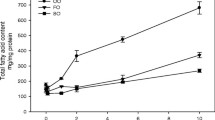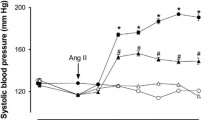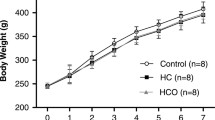Abstract
Lipid emulsions for parenteral nutrition are used to provide calories and essential fatty acids for patients. They have been associated with hypertriglyceridemia, hypercholesterolemia, and metabolic stress, which may promote the development of endothelial dysfunction in patients. The aim of the present study was to determine whether five different industrial lipid emulsions may affect the endothelial function of coronary arteries. Porcine coronary artery rings were incubated with lipid emulsions 0.5, 1, or 2% (v/v) for 30 min before the determination of vascular reactivity in organ chambers and the level of oxidative stress using electron paramagnetic resonance. Incubation of coronary artery rings with either Lipidem®, Medialipid® containing long- and medium-chain triacylglycerols (LCT/MCT), or SMOFlipid® containing LCT, MCT, omega-9, and -3, significantly reduced the bradykinin-induced endothelium-dependent relaxation, affecting both the nitric oxide (NO) and endothelium-dependent hyperpolarization (EDH) components, whereas, Intralipid® containing LCT (soybean oil) and ClinOleic® containing LCT (soybean and olive oil) did not have such an effect. The endothelial dysfunction induced by Lipidem® was significantly improved by indomethacin, a cyclooxygenase (COX) inhibitor, inhibitors of oxidative stress (N-acetylcysteine, superoxide dismutase, catalase) and transition metal chelating agents (neocuproine, tetrathiomolybdate, deferoxamine and l-histidine). Lipidem® significantly increased the arterial level of oxidative stress. The present findings indicate that lipid emulsions containing LCT/MCT induce endothelial dysfunction in coronary artery rings by blunting both NO- and EDH-mediated relaxations. The Lipidem®-induced endothelial dysfunction is associated with increased vascular oxidative stress and the formation of COX-derived vasoconstrictor prostanoids.





Similar content being viewed by others
Abbreviations
- DHA:
-
Docosahexaenoic acid (22:6n-3)
- EDH:
-
Endothelium-dependent hyperpolarization
- EPA:
-
Eicosapentaenoic acid (20:5n-3)
- KCN:
-
Potassium cyanide
- LCT:
-
Long chain triacylglycerols
- MCT:
-
Medium chain triacylglycerols
- MnTMPyP:
-
Mn(III) Tetrakis(1-methyl-4 pyridyl) porphyrin
- NAC:
-
N-acetylcysteine
- NO:
-
Nitric oxide
- PUFA:
-
Polyunsaturated fatty acid
- ROS:
-
Reactive oxygen species
- VAS-2870:
-
3-Benzyl-7-(2-benzoxazolyl) thio-1,2,3-triazolo (4,5-d) pyrimidine
References
Chan S, McCowen KC, Bistrian B (1998) Medium-chain triglyceride and n-3 polyunsaturated fatty acid-containing emulsions in intravenous nutrition. Curr Opin Clin Nutr Metab Care 1:163–169
Ziegler TR (2009) Parenteral nutrition in the critically ill patient. N Engl J Med 361:1088–1097
Boisramé-Helms J, Toti F, Hasselmann M, Meziani F (2015) Lipid emulsions for parenteral nutrition in critical illness. Prog Lip Res 60:1–16
Tilley SL, Coffman TM, Koller BH (2001) Mixed messages: modulation of inflammation and immune responses by prostaglandins and thromboxanes. J Clin Invest 108:15–23
Markowitz S, Neal JM (2009) Immediate lipid emulsion therapy in the successful treatment of bupivacaine systemic toxicity. Reg Anesth Pain Med 34:276
Steinberg HO, Tarshoby M, Monestel R, Hook G, Cronin J, Johnson A, Bayazeed B, Baron AD (1997) Elevated circulating free fatty acid levels impair endothelium-dependent vasodilation. J Clin Invest 100:1230–1239
Gosmanov AR, Smiley DD, Peng L, Siquiera J, Robalino G, Newton C, Umpierrez GE (2012) Vascular effects of intravenous intralipid and dextrose infusions in obese subjects. Metab Clin Exp 61:1370–1376
De Kreutzenberg SV, Crepaldi C, Marchetto S, Calo L, Tiengo A, Del Prato S, Avogaro A (2000) Plasma free fatty acids and endothelium-dependent vasodilation: effect of chain-length and cyclooxygenase inhibition. J Clin Endocrinol Metab 85:793–798
Steer P, Basu S, Lithell H, Vessby B, Berne C, Lind L (2003) Acute elevations of medium- and long-chain fatty acid have different impacts on endothelium-dependent vasodilation in humans. Lipids 38:15–19
Edirisinghe I, McCormick Hallam K, Kappagoda CT (2006) Effect of fatty acids on endothelium-dependent relaxation in the rabbit aorta. Clin Sci 111:145–151
Carpentier YA, Simoens C, Siderova V, el Nakadi I, Vanweyenberg V, Eggerickx D, Deckelbaum RJ (1997) Recent developments in lipid emulsions: relevance to intensive care. Clin Nutr 13:73S–78S
Waitzberg DL, Torrinhas RS, Jacintho TM (2006) New parenteral lipid emulsions for clinical use. J Parenter Enteral Nutr 30:351–367
Liang B, Wang S, Ye YJ, Yang XD, Wang YL, Qu J, Xie QW, Yin MJ (2008) Impact of postoperative omega-3 fatty acid-supplemented parenteral nutrition on clinical outcomes and immunomodulations in colorectal cancer patients. World J Gastroenterol 14:2434–2439
Calder PC (2009) Hot topics in parenteral nutrition. Rationale for using new lipid emulsions in parenteral nutrition and a review of the trials performed in adults. Proc Nutr Soc 68:252–260
Mayer K, Grimm H, Grimminger F, Seeger W (2002) Parenteral nutrition with n-3 lipids in sepsis. Br J Nutr 87:S69–S75
Zgheel F, Alhosin M, Rashid S, Burban M, Auger C, Schini-Kerth VB (2014) Redox-sensitive induction of Src/PI3-kinase/Akt and MAPKs pathways activate eNOS in response to EPA:DHA 6:1. PLoS One 18:105102
Nakashima M, Mombouli JV, Taylor AA, Vanhoutte PM (1993) Endothelium-dependent hyperpolarization caused by bradykinin in human coronary arteries. J Clin Invest 92:2867–2871
Auger C, Kim J-H, Trinh S, Chataigneau T, Popken AM, Schini-Kerth VB (2011) Fruit juice-induced endothelium-dependent relaxations in isolated porcine coronary arteries: evaluation of different fruit juices and purees and optimization of a red fruit juice blend. Food Funct 2:245–250
Anselm E, Chataigneau M, Ndiaye M, Chataigneau T, Schini-Kerth VB (2007) Grape juice causes endothelium-dependent relaxation via a redox-sensitive Src- and Akt-dependent activation of eNOS. Cardiovasc Res 73:404–413
Rivilla F, Vallejo S, Peiro C, Sanchez-Ferrer CF (2012) Characterization of endothelium-dependent relaxations in the mesenteric vasculature: a comparative study with potential pathophysiological relevance. J Pediatr Surg 47:2044–2049
Heaps CL, Robles JC, Sarin V, Mattox ML, Parker JL (2014) Exercise training-induced adaptations in mediators of sustained endothelium-dependent coronary artery relaxation in a porcine model of ischemic heart disease. Microcirculation 21:388–400
Félétou M, Huang Y, Vanhoutte PM (2010) Vasoconstrictor prostanoids. Pflüg Arch-Eur. J Physiol 459:941–950
Feletou M, Huang Y, Vanhoutte PM (2011) Endothelium-mediated control of vascular tone: COX-1 and COX-2 products. Br J Pharmacol 164:894–912
Ricciotti E, FitzGerald GA (2011) Prostaglandins and inflammation. Arterioscler Thromb Vasc Biol 31:986–1000
Caughey GE, Cleland LG, Penglis PS, Gamble JR, James MJ (2001) Roles of cyclooxygenase (COX)-1 and COX-2 in prostanoid production by human endothelial cells: selective up-regulation of prostacyclin synthesis by COX-2. J Immunol 167:2831–2838
Morin C, Sirois M, Echave V, Rizcallah E, Rousseau E (2009) Relaxing effects of 17(18)-EpETE on arterial and airway smooth muscles in human lung. Am J Physiol Lung Cell Mol Physiol 296:L130–L139
Adkins Y, Kelley DS (2010) Mechanisms underlying the cardioprotective effects of omega-3 polyunsaturated fatty acids. J Nutr Biochem 21:781–792
de Kreutzenberg SV, Puato M, Kiwanuka E, Del Prato S, Pauletto P, Pasini L, Tiengo A, Avogaro A (2003) Elevated non-esterified fatty acids impair nitric oxide independent vasodilation, in humans: evidence for a role of inwardly rectifying potassium channels. Atherosclerosis 169:147–153
Krohn K, Koletzko B (2006) Parenteral lipid emulsions in paediatrics. Curr Opin Clin Nutr Metab Care 9:319–323
Umpierrez GE, Smiley D, Robalino G, Peng L, Kitabchi AE, Khan B, Le A, Quyyumi A, Brown V, Phillips LS (2009) Intravenous intralipid-induced blood pressure elevation and endothelial dysfunction in obese African-Americans with type 2 diabetes. J Clin Endocrinol Metab 94:609–614
Steer P, Millgard J, Basu S, Lithell H, Vessby B, Berne C, Lind L (2003) Vitamin C, diclophenac, and l-arginine protect endothelium-dependent vasodilation against elevated circulating fatty acid levels in humans. Atherosclerosis 168:65–72
Chu LM, Robich MP, Bianchi C, Feng J, Liu Y, Xu SH, Burgess T, Sellke FW (2012) Effects of cyclooxygenase inhibition on cardiovascular function in a hypercholesterolemic swine model of chronic ischemia. Am J Physiol Heart Circ Physiol 302:479–488
Inoguchi T, Li P, Umeda F, Yu HY, Kakimoto M, Imamura M, Aoki T, Etoh T, Hashimoto T, Naruse M, Sano H, Utsumi H, Nawata H (2000) High glucose level and free fatty acid stimulate reactive oxygen species production through protein kinase C–dependent activation of NAD(P)H oxidase in cultured vascular cells. Diabetes 49:1939–1945
Li JM, Shah AM (2004) Endothelial cell superoxide generation: regulation and relevance for cardiovascular pathophysiology. Am J Physiol Regul Integr Comp Physiol 287:R1014–R1030
Chinen I, Shimabukuro M, Yamakawa K, Higa N, Matsuzaki T, Noguchi K, Ueda S, Sakanashi M, Takasu N (2007) Vascular lipotoxicity: endothelial dysfunction via fatty-acid-induced reactive oxygen species overproduction in obese Zucker diabetic fatty rats. Endocrinology 148:160–165
Batchuluun B, Inoguchi T, Sonoda N, Sasaki S, Inoue T, Fujimura Y, Miura D, Takayanagi R (2014) Metformin and liraglutide ameliorate high glucose-induced oxidative stress via inhibition of PKC-NAD(P)H oxidase pathway in human aortic endothelial cells. Atherosclerosis 232:156–164
Osanai H, Okumura K, Hayakawa M, Harada M, Numaguchi Y, Mokuno S, Murase K, Matsui H, Toki Y, Ito T, Hayakawa T (2000) Ascorbic acid improves postischemic vasodilatation impaired by infusion of soybean oil into canine iliac artery. J Cardiovas Pharmacol 36:687–692
Ilan E, Tirosh O, Madar Z (2005) Triacylglycerol-mediated oxidative stress inhibits nitric oxide production in rat isolated hepatocytes. J Nutr 135:2090–2095
Gutteridge JM, Halliwell B (2010) Antioxidants: molecules, medicines, and myths. Biochem Biophys Res Commun 393:561–564
Beckman JS, Koppenol WH (1996) Nitric oxide, superoxide, and peroxynitrite: the good, the bad, and ugly. Am J Physiol 271:C1424–C1437
Van de Velde M, Wouters PF, Rolf N, Van Aken H, Vandermeersch E (1998) Comparative hemodynamic effects of three different parenterally administered lipid emulsions in conscious dogs. Crit Care Med 26:132–137
Boisrame-Helms J, Said A, Burban M, Delabranche X, Stiel L, Zobairi F, Hasselmann M, Schini-Kerth V, Toti F, Meziani F (2014) Medium-chain triglyceride supplementation exacerbates peritonitis-induced septic shock in rats: role on cell membrane remodeling. Shock 42:548–553
Ok SH, Lee SH, Yu J, Park J, Shin IW, Lee Y, Cho H, Choi MJ, Baik J, Hong JM, Han JY, Lee HK, Chung YK, Sohn JT (2015) Lipid emulsion attenuates acetylcholine-induced relaxation in isolated rat aorta. Bio Med Res Int 2015:871545
Vanek VW, Seidner DL, Allen P, Bistrian B, Collier S, Gura K, Miles JM, Valentine CJ, Kochevar M (2012) Clinical role for alternative intravenous fat emulsions. Nutrition in clinical practice. Am Soc Parenter Enteral Nutr 27:150–192
Leaf A, Weber PC (1988) Cardiovascular effects of n-3 fatty acids. N Engl J Med 318:549–557
Granato D, Blum S, Rössle C, Le Boucher J, Malnoë A, Dutot G (2000) Effects of parenteral lipid emulsions with different fatty acid composition on immune cell functions in vitro. J Parenter Enteral Nutr 24:113–118
Wanten GJ, Calder PC (2007) Immune modulation by parenteral lipid emulsions. Am J Clin Nutr 85:1171–1184
Grimm H, Mertes N, Goeters C, Schlotzer E, Mayer K, Grimminger F, Fürst P (2006) Improved fatty acid and leukotriene pattern with a novel lipid emulsion in surgical patients. Eur J Nutr 45:55–60
Author information
Authors and Affiliations
Corresponding author
Ethics declarations
Conflict of interest
The authors declare no conflict of interest.
About this article
Cite this article
Amissi, S., Boisramé-Helms, J., Burban, M. et al. Lipid Emulsions Containing Medium Chain Triacylglycerols Blunt Bradykinin-Induced Endothelium-Dependent Relaxation in Porcine Coronary Artery Rings. Lipids 52, 235–243 (2017). https://doi.org/10.1007/s11745-016-4225-y
Received:
Accepted:
Published:
Issue Date:
DOI: https://doi.org/10.1007/s11745-016-4225-y




